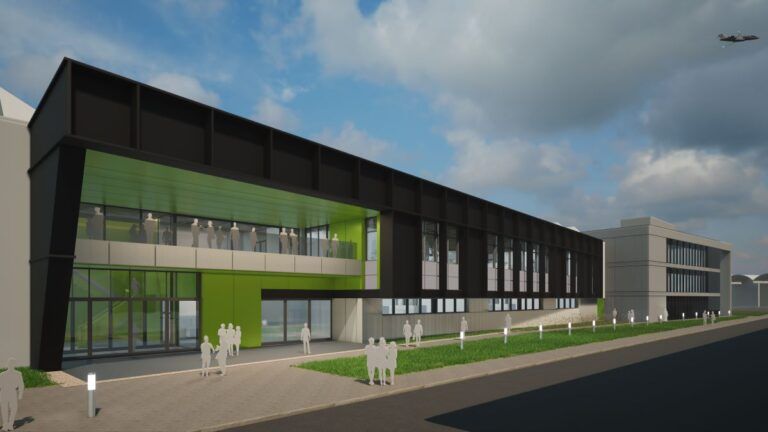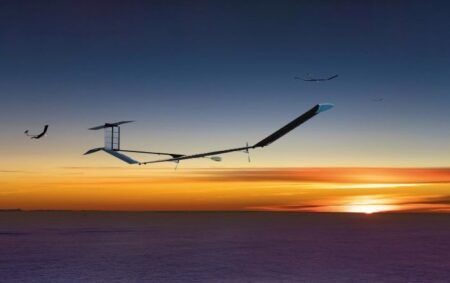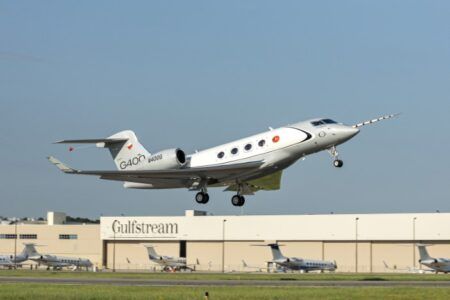Cranfield is a postgraduate-only research university located in the rolling hills of Bedfordshire an hour’s drive north of London. Founded in 1946 at a former WW2 airfield, to this day Cranfield is the only European university with its own airport.
As an aerospace-orientated university, Cranfield has to move with the times. It only attracts grants, industry investment and students if its experts, courses and research projects are at the forefront of innovation.
Around Cranfield’s campus, major construction work is happening now for new testing sites and laboratories, that will add vital new capabilities to help develop zero emission aircraft fueled by gaseous and liquid hydrogen.
Low carbon transition
In April 2024 the University won £69 million (US$90 million) for the CH2i (Cranfield Hydrogen Integration Incubator) program. This was the largest amount of funding Cranfield has ever won for a single project. The money is being used to build several new buildings and test facilities dedicated to researching hydrogen engines, sub-systems, fuel systems and storage.
John Horsley, hydrogen special projects manager at Cranfield, is overseeing the CH2i build program on campus. This involves liaising with supporting partners and researchers as well as booking the projects that will happen in them.
Thanks to a background that includes work in the automotive industry he recognizes that there are aspects of powertrain development that are common between that sector and aerospace. But key differences do exist. He says, “There are different requirements, such as vibration and the operating environment. The packaging requirements are also challenging in an aircraft.
“Taking liquid hydrogen and sending it through pipes, valves, and pumps means we have to look at embrittlement and the effects of cryogenic temperatures. The challenges are immense.”
“CH2i will be the first large-scale hydrogen research hub dedicated to solving these types of technical challenges around hydrogen’s use as an aviation fuel and helping to scale up its production and use.”
New build
Cranfield’s new Hydrogen Integration Research Centre (HIRC) is an extension to existing laboratories and will host low TRL work. A new research center is also being constructed that will contain several new 50-square-meter test cells. Each cell will hold different experiments that use gaseous hydrogen. The HIRC and the new test cells will be equipped for handling gaseous hydrogen.
“The rooms in the research center are open and not designated to any particular purpose. There will be sub-system setups, such as fuel systems and tanks. The bigger tests with turbines will be done at a test area on the edge of the campus, where we can evacuate more easily if necessary. A lot of the tests will be in the open or under Dutch barns,” says Horsley.
Hydrogen research currently happening at the engine testing area, such as a program looking at low NOx hydrogen combustion, is to be moved to the HIRC. This will enable the engine testing area to be reconfigured with CH2i funds to host all future liquid hydrogen (LH2) experiments and tests.
“If they need any liquid hydrogen in the labs we will transport small amounts there in a dewar,” says Horsley.
CH2i funding is also paying for a project to modernize Cranfield’s airport. This is the most expensive work package because it requires groundwork and repairs to the runway surfaces.
Fuel production
One of the aims of CH2i is to establish the production of LH2 on-site at Cranfield for use in testing. A green electrolyzer is being built on campus to generate gaseous hydrogen from water. This hydrogen will go to a liquefaction plant at the test area to make LH2. Production capacity will be 50kg (110 lbs) a day, with a 250kg (550 lbs) buffer tank. Cranfield is in the process of sourcing a supplier for the liquefaction plant.
“The challenge with LH2 is that it is supplied in units of two tons, mainly from Rotterdam. If you want 250kg for an experiment, which is the kind of amount we usually require, you end up throwing seven-eighths of it away,” says Horsley.
There are several industrial partners for CH2i, including hydrogen processing and production companies and aviation. Ground has been broken for the HIRC and research center buildings, sites are being cleared and planning permissions applied for the other areas. The HIRC and the research center will be open and running by summer next year.
“All of the hydrogen test cells have been booked for when we open already. Some are taking experiments that are already running in the existing test area, but there are several new experiments,” says Horsley.

Research focus
In total, £100 million (US$130 million) of R&D projects are being hosted at Cranfield over the next eight years. A large chunk of that is capital spending on CH2i. The second largest is £14 million (US$18 million) to set up a doctoral training center for PhD students. The centre will ready post-grads to work in industry on hydrogen and electrification technology projects. The center will help academia and the aviation industry transition to working with hydrogen and electrical technologies.
The first projects to use facilities built under CH2i will include the build and test of liquid hydrogen tanks and fuel systems. They will address the challenges around leakage that hydrogen poses, and develop lightweight materials for the tanks and pipes. Experiments will consider different fuel system architectures and layouts, sensing technologies for inside of the tank and advanced pumps.
Thermal management and control is another big challenge for hydrogen, as is the development of hazard control and mitigation strategies. Numerical research projects aim to understand cavitation in liquid hydrogen pumps, and the implications that unsteady flow will have on performance in LH2 fuel systems – bubbles, slugs and mist in the hydrogen flow.
The performance of the hydrogen tanks and fuel systems will be tested in negative or zero g conditions on with drop tests. Some tests will be done off-site at locations more suitable for riskier tests. “There is only so far you can get with numerical modeling. You need experimental data and validation eventually. That can happen thanks to CH2i, at all the different TRLs from material up to aircraft level,” says Professor Bobby Sethi, head of low emissions technologies and combustion group, centre for propulsion and thermal power engineering and chair of Cranfield University’s Hydrogen Strategy Committee.
“We have projects on campus working with liquid hydrogen and cryogenics, materials, storage tanks, gas turbines, low-NOx combustion, infrastructure and ground operations. They involve major industry players. CH2i enables the delivery of some of these ongoing experimental projects and will enable new projects.”
Phases of hydrogen
Sethi predicts a phased introduction for hydrogen aircraft. The next 10 to 15 years will demonstrate their viability, safety and closely involve certification bodies. “You can’t compete with kerosene aircraft during this phase, so we will need financial support from government,” he says.
The second phase will start in around 20 years and will see the focus shift to improving the efficiency of hydrogen aircraft. It isn’t until more than 30 years from now that hydrogen aircraft begin to rival tube and wing kerosene aircraft in terms of efficiency, Sethi believes.
He also sees tackling the decarbonization of long-distance flights with alternative fuels as a high priority. 70% of commercial departures are for flights that are under 1,000 miles (1,600km), but these only represent 30% of aviation’s total fuel burn. “A fuel cell large enough for longer range flights will, like be too heavy for large aircraft. Only a gas turbine has the far superior power-to-weight ratio needed for longer flights,” says Sethi.
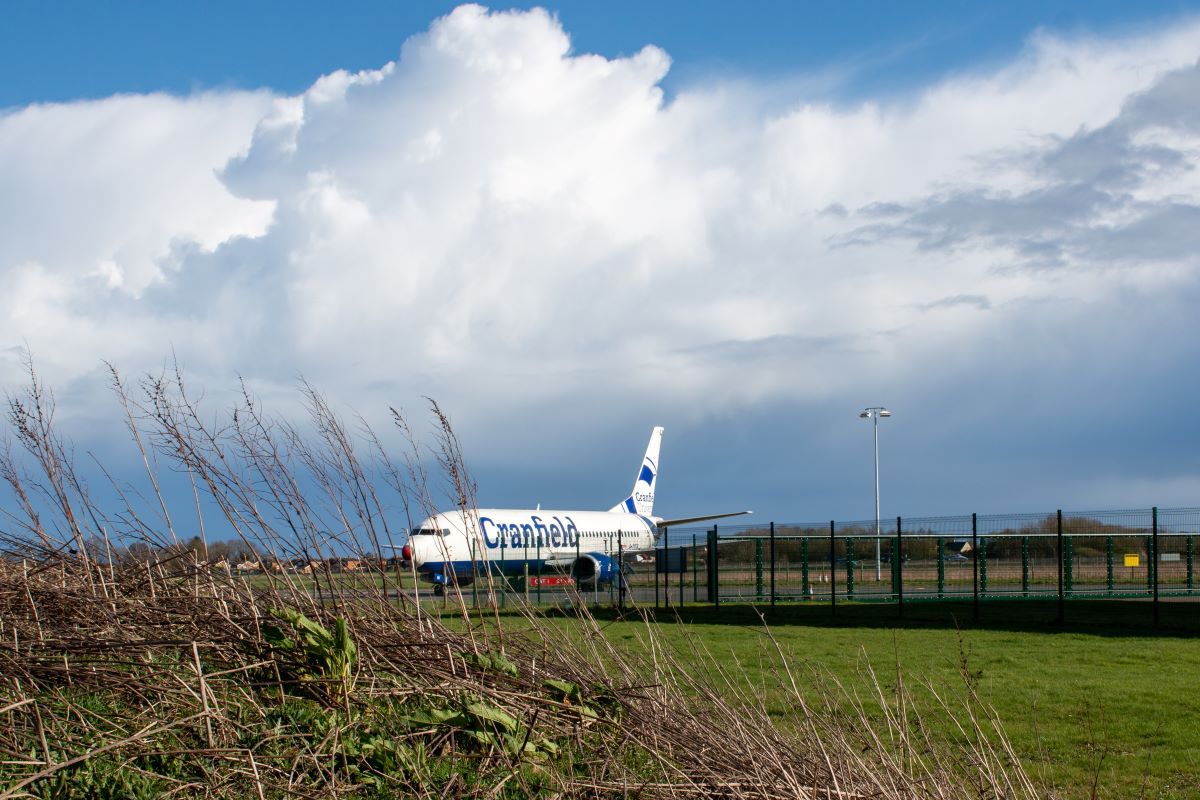
Flight testing
Cranfield’s airport will be used for flight tests and operational trials of hydrogen infrastructure and ground support equipment. Nearby firm Cranfield Aerospace, which is modifying a Britten Islander with a hydrogen propulsion system will use the airport for propulsion and fuel system tests and the first flight of the aircraft.
“We are spending a lot of time helping the CAA develop regulations and health safety guidelines. We work with them and Cranfield Aerospace on the testing side,” says Horsley. “The first things that have happened are in ground support equipment and on the operational aspects of hydrogen. That includes refueling, which technically is possible, but the CAA has to be satisfied it is safe.”
C2Hi is critical for the future of Cranfield and the UK to stay relevant in the industry argues Horsley: “It is essential we can accommodate hydrogen testing because it is the direction the aviation industry is moving in,” he says. “Cranfield has a role to play in enabling hydrogen as an aviation fuel, working with the large companies, ensuring they can do their R&D here and so keep their operations in the UK.
“CH2i is a great start, but it takes up to 15 years to build a clean sheet design for an aircraft. We have one design cycle left before we need to hit net zero. It’s a challenging goal.”
Cranfield University has been involved in many of aerospace’s technology developments over the decades. The provision of testing facilities for hydrogen-fueled aircraft reflects another shift for the aviation industry and the makeup of Cranfield’s campus.
ONEheart project pioneers next generation aircraft development tools
The £26 million (US$34 million) Out of Cycle NExt generation highly efficient air transport (ONEheart) is a three-year Airbus-led project, that is part-funded by the UK Government and aims to develop the design and simulation tools and technologies to develop future aircraft. The ONEheart team is at the stage of validating the software tools and works at the Agile Concept Laboratory inside Cranfield’s Aerospace Integration Research Centre.
Professor Mark Westwood, professor of aeronautics at Cranfield University works on ONEheart and says, “The main question about the next generation of aircraft is what will the propulsion be and how will a change in propulsion system impact the shape and design?
“When you start considering alternative aircraft shapes the tools are not validated like they are for existing designs. There is more uncertainty, which makes the development lifecycle longer. Plus, we need to explore a wider range of concepts.”
“We are developing tools and ways to accelerate the design process. The tools simulate things like handling qualities and flight dynamics,” says Dr Estela Bragado Aldana, research fellow in flight modeling and simulation at Cranfield.
Different physics simulations are applied to the 3D computer models to predict performance and handling. The results are combined with real-world flight data gathered from Cranfield’s flying testbed aircraft, a Saab 340. The models are then flight-tested in a simulator, where feedback from a pilot is incorporated into the design process. “The feedback could be that the aircraft is sluggish or the stability or roll response is poor,” adds Aldana. “Flight testing early in the design stage digitally allows us to iterate faster.”
Looking forward to hydrogen aircraft cockpits
A recent project at Cranfield’s AIRC has developed a fixed base simulator to explore the human factors aspects of future hydrogen aircraft. The cockpit model is based on an A320’s, but with added touchscreens and glass.
“The simulator is a basic interpretation of what the dashboard and cockpit of a hydrogen aircraft would look like,” says project lead Declan Saunders, research assistant transport systems, Rolls Royce Future Systems Simulator at Cranfield University.
The project has recreated scenarios such as failure modes including fuel pump failures. This type of information needs to be supplied to the cockpit and pilot efficiently and effectively.
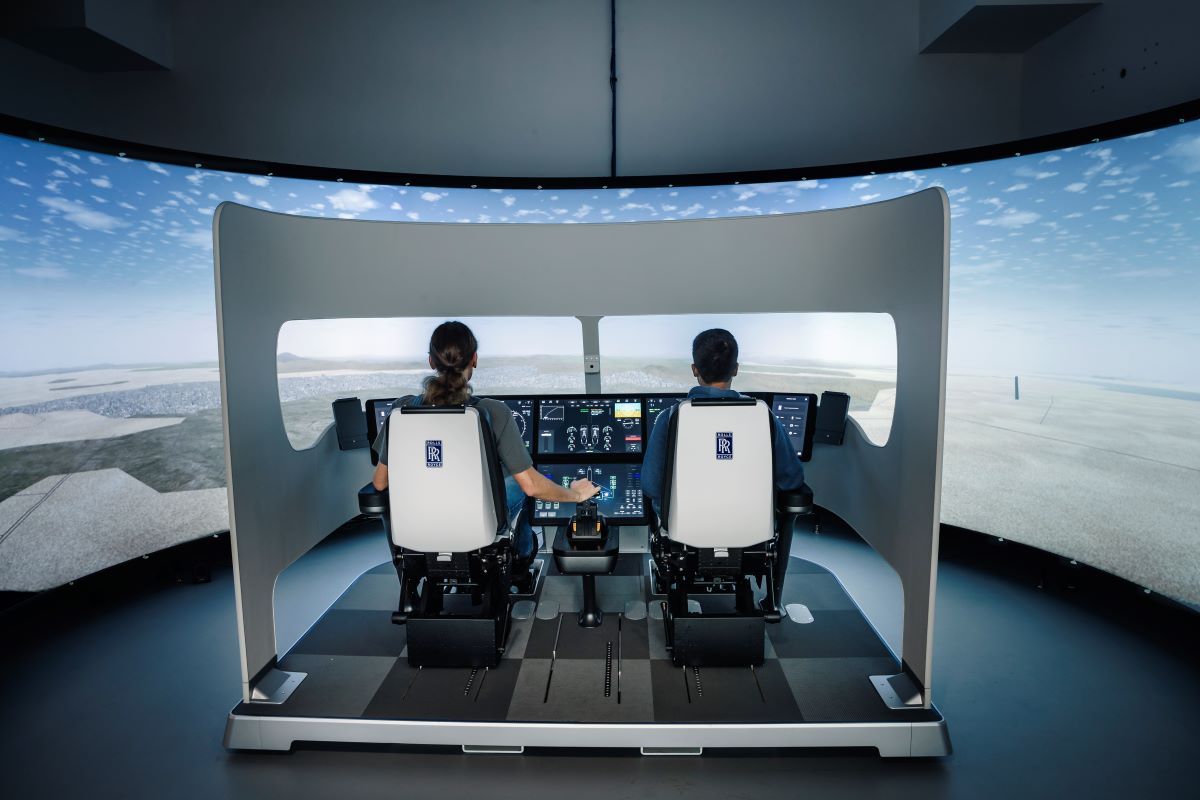
“We are looking at how do we put information into the cockpit quickly and display it simply when the pilot has very little time to deal with an incident,” says Saunders.
Another area being examined is new systems and functions. For example, nitrogen is needed to purge the aircraft’s fuel system before and after each hydrogen refuel. Startup procedures for a hydrogen aircraft will also be radically different – the fuel is kept at -253°C and the aircraft is likely to be attached to a ground conditioner.
The project finished in September 2024 and a report was submitted to Rolls-Royce in November. “We want to represent hydrogen aircraft to the industry and regulators to show they are a safe possibility,” Saunders adds.


